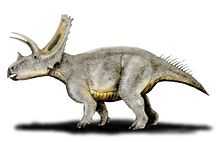Titanoceratops
| Titanoceratops Temporal range: Late Cretaceous, 74.5–73.7Ma | |
|---|---|
 | |
| Mounted holotype at the Oklahoma Museum of Natural History | |
| Scientific classification | |
| Kingdom: | Animalia |
| Phylum: | Chordata |
| Clade: | Dinosauria |
| Order: | †Ornithischia |
| Family: | †Ceratopsidae |
| Subfamily: | †Chasmosaurinae |
| Tribe: | †Triceratopsini |
| Genus: | †Titanoceratops Longrich, 2011 |
| Species: | † T. ouranos |
| Binomial name | |
| Titanoceratops ouranos Longrich, 2011 | |
Titanoceratops (meaning "titanic horn face") is a genus of herbivorous ceratopsian dinosaur. It was a giant chasmosaurine ceratopsian which lived during the Late Cretaceous period (late Campanian, 74.5–73.7 Ma) in what is now New Mexico, and the earliest known triceratopsin. It is known solely from the holotype OMNH 10165, a partial skeleton including partial skull and jaws. The holotype is thought to come from the upper Fruitland Formation or the lower Kirtland Formation based on field notes and the lithology of the matrix surrounding the fossils, but unfortunately the precise location of the quarry is no longer known. The species was formally named by Nicholas R. Longrich in 2011 and the type species is Titanoceratops ouranos. Previously, its fossils were assigned to Pentaceratops.[1]


The skull is estimated to be 2.65 m (8.7 ft) long when complete, making it a candidate for the longest skull of any terrestrial vertebrate.[1] Tom Holtz (2010) noted that it is extremely similar to its closely related contemporaries Eotriceratops and Ojoceratops, which may all be synonymous.[2]
References
- ↑ 1.0 1.1 Nicholas R. Longrich (2011). "Titanoceratops ouranos, a giant horned dinosaur from the Late Campanian of New Mexico". Cretaceous Research 32 (3): 264–276. doi:10.1016/j.cretres.2010.12.007.
- ↑ Holtz, Thomas R. Jr. (2011) Dinosaurs: The Most Complete, Up-to-Date Encyclopedia for Dinosaur Lovers of All Ages, Winter 2010 Appendix.